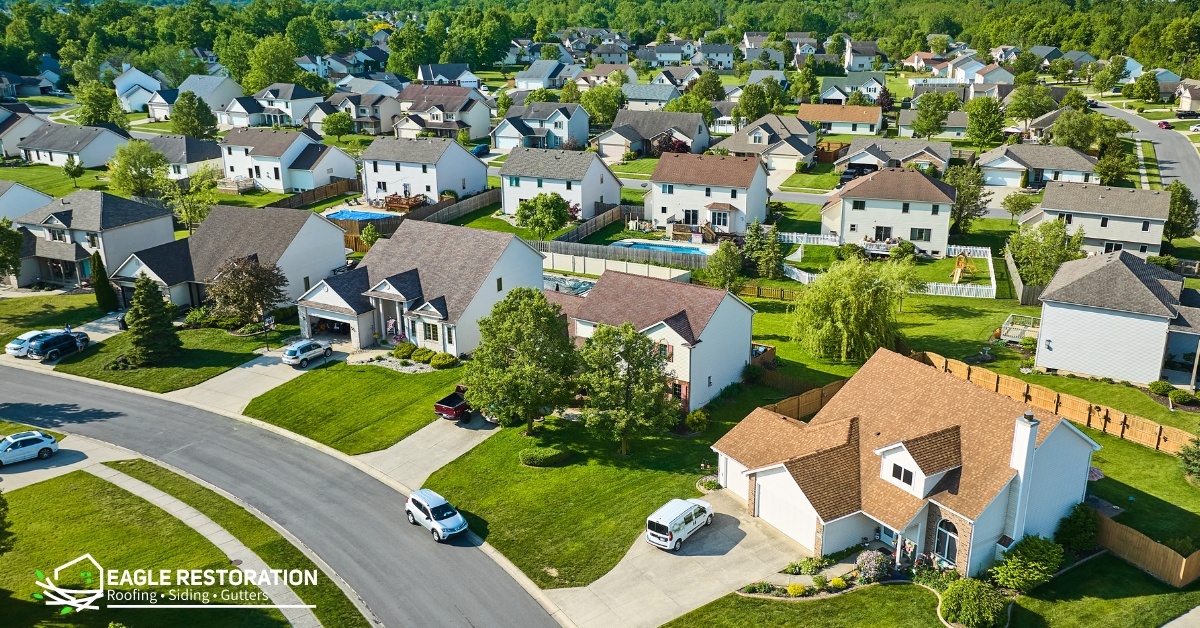James Hardie vs. Vinyl Siding: The Best Choice for Homes in Central Indiana
When upgrading your home’s exterior, choosing the right siding material is one of the most...
By: Eagle Restoration Jul 21, 2025 10:30:26 AM

What Every Homeowner Should Know to Protect Their Investment
Indiana summers can be beautiful—but they also bring heavy humidity that lingers for weeks at a time. While most homeowners know how that sticky weather feels on their skin, many don’t realize what it can do to their roof. Over time, heat and humidity can wear down roofing materials, shorten your roof’s lifespan, and even create conditions for serious problems like mold and rot.

At Eagle Restoration, we want Central Indiana homeowners to be aware of what to watch for and how to stay ahead of issues before they become costly repairs. Here’s a look at how Indiana’s humid summers can affect your roof—and what you can do to protect it.
High humidity levels can lead to excess moisture collecting beneath your roof’s surface, especially under shingles or around flashing and vents. If your attic isn't properly ventilated, this moisture has nowhere to go. Over time, it can seep into decking, insulation, and even your home’s structure.

What to watch for:
Warped or curled shingles
Soft spots on the roof
Water stains on ceilings or attic rafters
Humid, shaded areas of your roof are perfect breeding grounds for mold, mildew, and algae—especially if your roof doesn’t get a lot of direct sunlight. While algae and mold might start as cosmetic issues, they can quickly break down roofing materials and affect indoor air quality if they spread inside.

Tip: If you notice dark streaks or green patches on your roof, don’t ignore them. A roof inspection can determine if it’s just surface-level or something deeper.
Wood components like roof decking and fascia boards are especially vulnerable to excess moisture. Once wood starts to rot, it compromises the integrity of the roof and can eventually lead to sagging or collapse in extreme cases.
Prevention starts with:
Adequate attic ventilation
Routine inspections after storms
Prompt repairs when water damage is detected
Asphalt shingles, the most common roofing material in Indiana, don’t just absorb moisture—they also expand and contract with temperature swings. The combination of heat and humidity can cause shingles to blister, crack, or warp over time, which weakens your roof’s ability to shed water.
What this means for your home: Damaged shingles increase the risk of leaks and leave your roof vulnerable to storm damage when those summer thunderstorms roll in.
Proper attic ventilation is key to minimizing humidity’s impact on your roof. Without it, heat and moisture become trapped under the roof deck, raising the temperature of your attic and accelerating wear and tear.
How to tell if your attic is poorly ventilated:
Your upstairs rooms feel hotter than the rest of your home
You notice high energy bills in the summer
You find condensation or damp insulation in your attic
If this sounds familiar, it may be time for a ventilation upgrade.
It might seem strange to think about winter while you’re sweating through July, but humidity-related damage can have lasting effects into the next season. If moisture gets trapped in the roof deck and insulation, it can lead to uneven roof temperatures come winter—creating ideal conditions for ice dams to form.

You can’t control the weather, but you can control how well your roof handles it. Here are a few ways to stay proactive:
Schedule an annual roof inspection. Especially before and after the peak of summer.
Ensure your attic is properly ventilated and insulated.
Trim overhanging trees that create shaded, damp areas on your roof.
Clean your gutters regularly to prevent water from backing up onto the roof.
Call a professional at the first sign of trouble. Don’t wait until moisture damage spreads.
At Eagle Restoration, we know what Indiana weather can do to a roof. Our team is local, experienced, and ready to help you protect your home through the heat of summer and beyond. Whether you need a quick inspection, a ventilation upgrade, or full roof repairs, we’ve got you covered.

Don’t wait for problems to get worse—schedule your free inspection today. Let’s make sure your roof is ready for whatever Indiana throws at it.
When upgrading your home’s exterior, choosing the right siding material is one of the most...
Choosing the right siding for your home is a big decision. Your siding not only defines the look of...
When you're looking at gutter replacement...